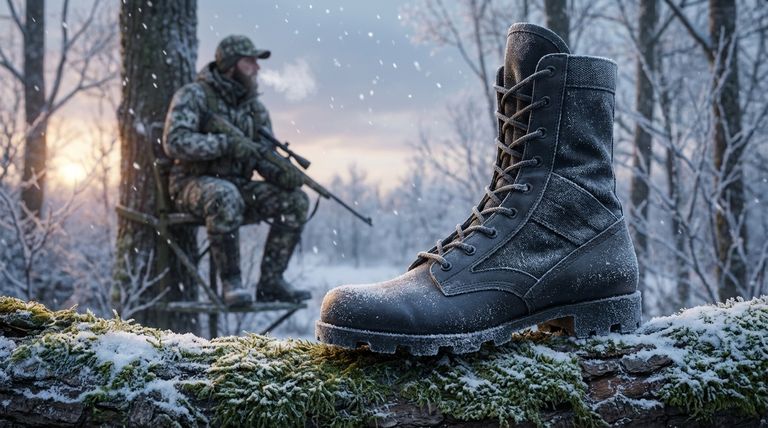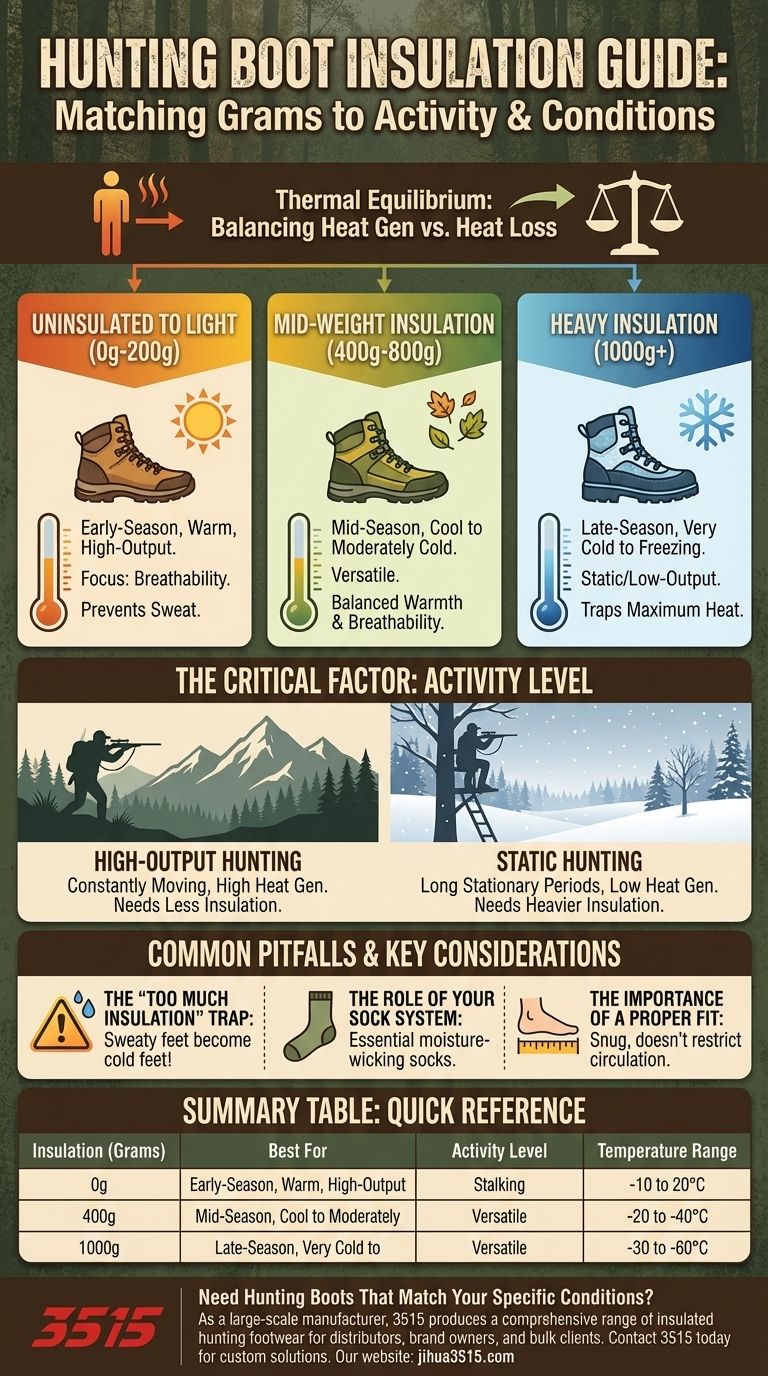Selecting the right hunting boot insulation is a critical decision that directly impacts your comfort, safety, and endurance in the field. The key is to match the insulation level, measured in grams, to your specific activity level and the expected temperature. Ratings typically range from uninsulated (0g) for warm, active hunts to over 1200g for extreme cold, static conditions.
The amount of insulation in your boots is not a simple case of "more is always better." The goal is to achieve thermal equilibrium—balancing the heat your body generates with the heat lost to the environment to keep your feet dry and comfortable.

Deconstructing Insulation: What the Grams Mean
Boot insulation is a synthetic material whose density is measured in grams. A higher gram count signifies thicker, warmer insulation designed to trap more of your body heat.
Uninsulated (0g) to Light Insulation (200g)
Uninsulated boots are for early-season hunts in warm weather where your primary concern is breathability. Lightly insulated boots, around 200 grams, are best for cool temperatures or for active hunters who generate significant body heat even on colder days.
Mid-Weight Insulation (400g - 800g)
This is often the most versatile range. Boots with 400 to 800 grams of insulation are suitable for a wide variety of mid-season hunts where temperatures are cool to moderately cold. They offer a good balance of warmth for periods of inactivity and breathability for periods of movement.
Heavy Insulation (1000g+)
Boots with 1000 grams or more are specialized for late-season hunts in very cold to freezing conditions. They are ideal when you will be stationary for long periods, such as sitting in a tree stand or ground blind, where your body is not generating much heat.
The Critical Factor: Your Activity Level
The temperature outside is only half of the equation. The other half is the heat you generate yourself.
High-Output Hunting
If you are constantly moving—stalking through mountains or walking fields—your body will produce a great deal of heat. In this scenario, less insulation is required to prevent your feet from sweating, which can lead to blisters and subsequent heat loss.
Static Hunting
Conversely, if your hunt involves long periods of sitting still in a blind or stand, your body will generate very little heat. In this case, you need heavier insulation to trap what little heat you produce and protect your feet from the ambient cold.
Common Pitfalls and Key Considerations
Choosing the right insulation level is a balancing act. Understanding the potential mistakes is just as important as knowing the gram ratings.
The "Too Much Insulation" Trap
The most common mistake is over-insulating. If your boots are too warm for your activity level, your feet will sweat. That moisture gets trapped, cools down, and will ultimately make your feet feel much colder than if you had worn less insulation. Wet feet are cold feet.
The Role of Your Sock System
Insulation works as a system, and your socks are a critical part of it. Never test or wear your hunting boots without the exact socks you plan to hunt in. Quality moisture-wicking socks (like wool or synthetics) are essential to pull sweat away from your skin.
The Importance of a Proper Fit
When trying on insulated boots, ensure a snug fit that doesn't restrict circulation. Toes that are crammed together will get cold faster, regardless of the insulation rating. Your feet also swell slightly during the day, so it's best to try on boots in the afternoon.
Making the Right Choice for Your Hunt
Your boot choice should be a deliberate decision based on your specific hunting style and environment. Many serious hunters own multiple pairs to match the conditions of the day.
- If your primary focus is early-season, active hunting: Choose uninsulated (0g) or lightly insulated (up to 200g) boots to maximize breathability and prevent sweat.
- If your primary focus is mid-season, mixed-activity hunting: Opt for versatile mid-weight insulation (400g-800g) that can handle cool mornings and active afternoons.
- If your primary focus is late-season, static hunting in the cold: Select heavily insulated boots (1000g or more) to retain crucial heat while you are stationary for long periods.
Investing in the right insulation system empowers you to focus entirely on the hunt, not your feet.
Summary Table:
| Insulation Level (Grams) | Best For | Activity Level | Temperature Range |
|---|---|---|---|
| 0g - 200g | Early-season, warm weather, or active hunts | High-Output (e.g., stalking, hiking) | Warm to Cool |
| 400g - 800g | Mid-season, versatile conditions | Mixed (e.g., walking and waiting) | Cool to Moderately Cold |
| 1000g+ | Late-season, extreme cold, static hunting | Low-Output (e.g., tree stand, blind) | Very Cold to Freezing |
Need Hunting Boots That Match Your Specific Conditions?
As a large-scale manufacturer, 3515 produces a comprehensive range of insulated hunting footwear for distributors, brand owners, and bulk clients. Our production capabilities encompass all types of boots, from lightweight, breathable models for active hunts to heavily insulated boots for extreme cold. We ensure the right fit, insulation, and durability so you can focus on the hunt.
Contact 3515 today for a custom solution that keeps your feet comfortable and protected, no matter the season or terrain.
Visual Guide

Related Products
- Durable Military Combat Boots with Water Drainage for Wholesale & OEM
- Safety Footwear Wholesale Manufacturer for Custom OEM/ODM Production
- Factory Direct Wholesale Rain Boots Durable Waterproof & Fully Customizable
- Wholesale Lightweight Tactical Boots with Dial Closure OEM & Bulk Orders
- Premium Grain Leather Safety Boots for Bulk Supply
People Also Ask
- What are military boots designed for? Unmatched Durability & Protection for Extreme Conditions
- What replaced jungle boots in the US military? The Shift to Tan Suede Combat Boots
- Why has Cordura remained relevant despite new fabrics? The Unbeatable Balance of Durability & Comfort
- How did combat boots transition from military use to popular culture? From Battlefield to Fashion Statement
- What has been the global recognition of fabric for over 30 years? Industry's Trusted Benchmark for Durability



















